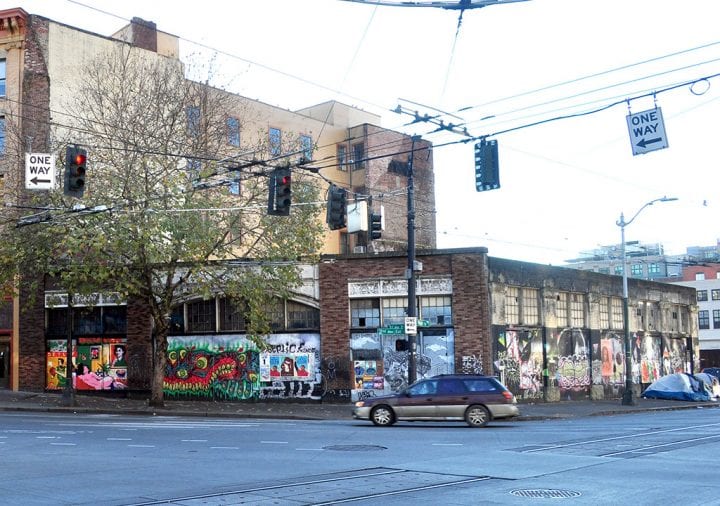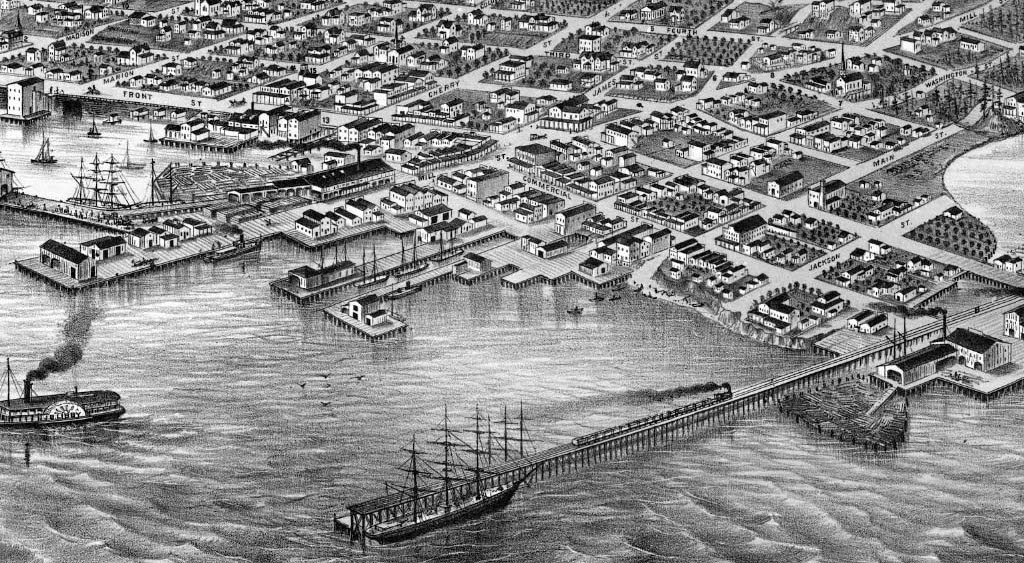Pioneer Square
by David B. Williams
-
Pioneer Square has long been an important location and center of activity for the residents of this area. The first to recognize its importance were the Native people, who have lived here for thousands of years. Prior to non-Native settlement, they used the area as a winter village known as Sdzidzilalitch, or Little Crossing-Over Place, building seasonal longhouses and taking advantage of the local resources in the forest and in the bay. The next arrivals were the Denny Party, considered to be the founders of Seattle, who arrived in 1852. For them the Pioneer Square area became the business and industrial heart of the small town. It also became the first place that many newcomers arrived and stayed, which led to the neighborhood’s evolution as a melting pot for diverse cultures. For many of these groups, Pioneer Square became home, sometimes by choice and sometimes because they were unwanted elsewhere.
The goal of this walk is to share the stories of those diverse cultures, as well as to highlight the early economic development of Seattle and how they helped further its diversity. A secondary goal is to highlight the use of natural resources and how that shaped the city’s development. These include Seattle’s first export, logs; its second major export and one often overlooked as central to Seattle’s economic development, coal quarried on the east side of Lake Washington; and finally, gold from the Klondike Gold Rush of 1897, which helped bring Seattle out of the nationwide economic panic of 1893.
One of the challenges of telling and showing the history of Pioneer Square is that many of the buildings and landmarks associated with a particular group or event have been destroyed. This is not surprising considering the long history of the area and how it reflects the constant changing nature of Seattle. In that light, this tour takes you to a variety of locations where you can learn about the history of the diverse groups that have called this place a home. At these stops where the building or structure associated with the history is no longer here, we use the phrase “Former location of.”
-
Steps: 2,345
Time: 2h 15m
Light Rail: Pioneer Square Station
Bus: King County Metro Trip Planner
Bus: Route 18
Tour Stops
Dzidzilalich (Little Crossing-Over Place)
City Datum Point Inscribed on Pioneer Building
St. Charles Hotel
Former Location of Carollton Hotel
Former Location of Free Speech Corner
Former Location of Double Header Bar
Former Location of Wa Chong Company Store
Union Gospel Mission/Former Location of Lou Graham’s
Former Location of Filipino Cannery Union
Klondike Gold Rush National Historical Park
Schwabacher Building
Former Location of Coal Bunkers
Former Location of Oregon Improvement Dock
Former Location of Ballast Island
Former Location of Yesler Mill
Former Location of Our House Restaurant and Hotel
Dzidzilalich (Little Crossing-Over Place)
Foot of Yesler Way at Alaskan Way S

City datum point inscribed on Pioneer Building
600 1st Avenue

St. Charles Hotel
81 S Washington St

Former location of Carollton Hotel
217 Occidental Avenue S

Former location of Free Speech Corner
S Washington Street and Occidental Avenue S

Former location of Double Header Bar
407 2nd Avenue Extension S

Former location of Wa Chong Company store
Northeast corner of 2nd Avenue Extension S and S Washington Street

Union Gospel Mission/Former location of Lou Graham’s
221 S Washington Street

Former location of Filipino Cannery Union
Southwest corner 2nd Avenue S and S Main Street

Klondike Gold Rush National Historical Park
319 2nd Avenue S

Schwabacher Building
401 1st Avenue S

Former location of Coal Bunkers
Marker on west side of Alaskan Way at S King Street

Former location of Oregon Improvement Dock
S Main Street and Alaskan Way

Former location of Ballast Island
Marker on west side of Alaskan Way at S Washington Street

Former location of Yesler Mill
Western Avenue and Yesler Way

Former location of Our House restaurant and hotel
Yesler Way and Post Alley



